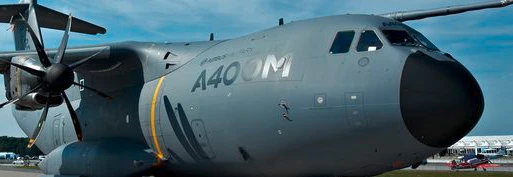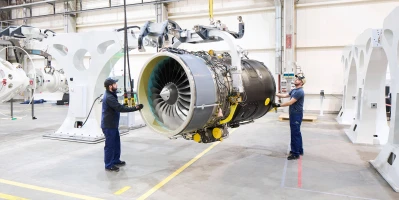good-to-know
Take the long way to Tenerife – experiencing the A220 on its longest route
The success of the Airbus A220 is due to its versatility in flying short hops as well as long routes. AEROREPORT joins airBaltic to experience the aircraft’s endurance.
author: Andreas Spaeth | 4 mins reading time published on: 06.04.2022
author:
Andreas Spaeth
has been traveling the world as a freelance aviation journalist for over 25 years, visiting and writing about airlines and airports. He is frequently invited to appear on radio and TV programs to discuss current events in the sector.

©Andreas Späth
It’s a sunny, yet very cold March morning in Riga. With temperatures dipping to minus 9°C during the night, the airBaltic billboard outside the airport terminal makes warm-water destinations like Dubai and Tenerife very tempting indeed. In fact, these routes to the Persian Gulf and the Canary Islands cover the greatest distances in the extensive airBaltic network. Even more noteworthy is that Riga to Tenerife is currently the world’s longest scheduled passenger route flown by the A220. Based in Latvia, a small country on Europe’s eastern edge, the airline has emerged as the world’s second largest operator of the twin-engine Airbus, behind U.S. giant Delta Air Lines. In March 2022, airBaltic added 33 aircraft to its all-A220 fleet, and seven more A220-300 aircraft are still due to join in 2022. For an airline to rely exclusively on Airbus’s newest product, originally called the Bombardier CSeries, is unprecedented.
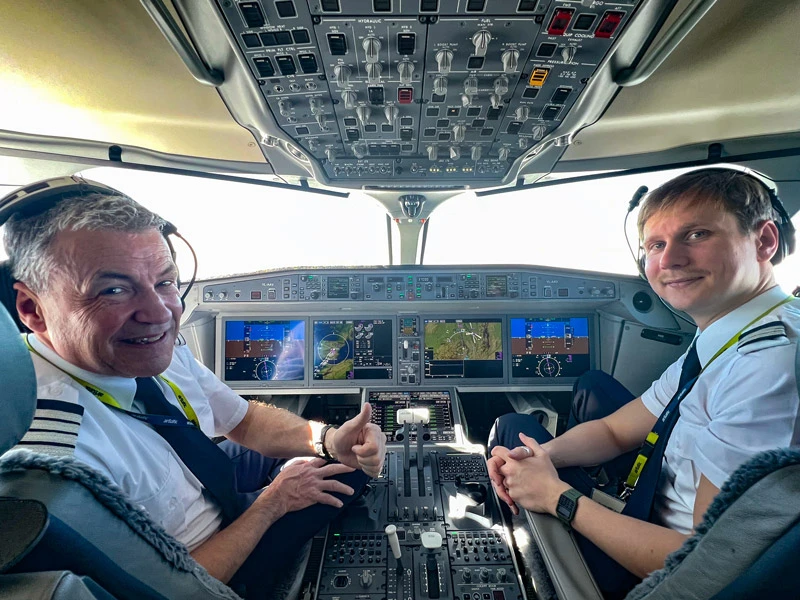

©Andreas Spaeth


©Andreas Spaeth
Experienced duo: Chief Pilot Gerhard Ramcke, with almost 10,000 flight hours in his logbook, and his First Officer Kalev Tarma bring the A220-300 safely to its destination.
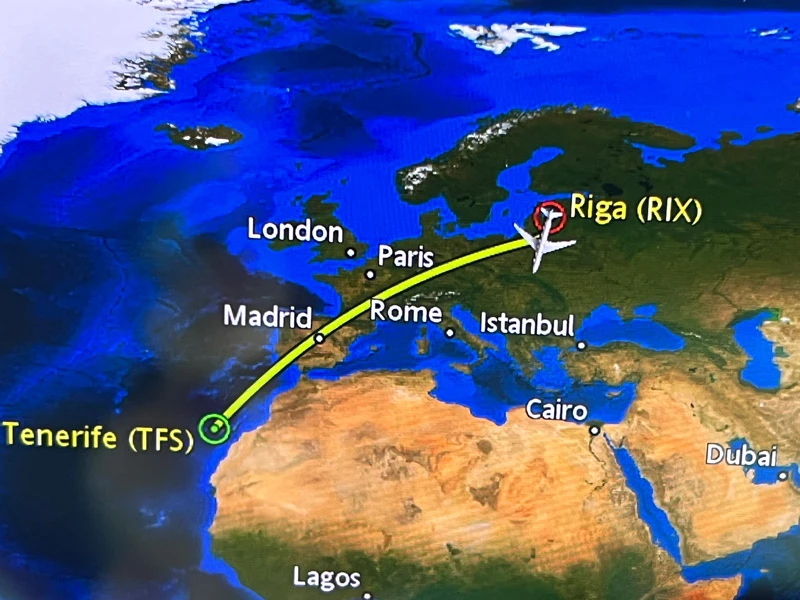

©Andreas Spaeth


©Andreas Spaeth
4,774 km, six hours and twelve minutes: The airBaltic route from Riga to Tenerife is the longest scheduled route to be served by an Airbus A220 to date.
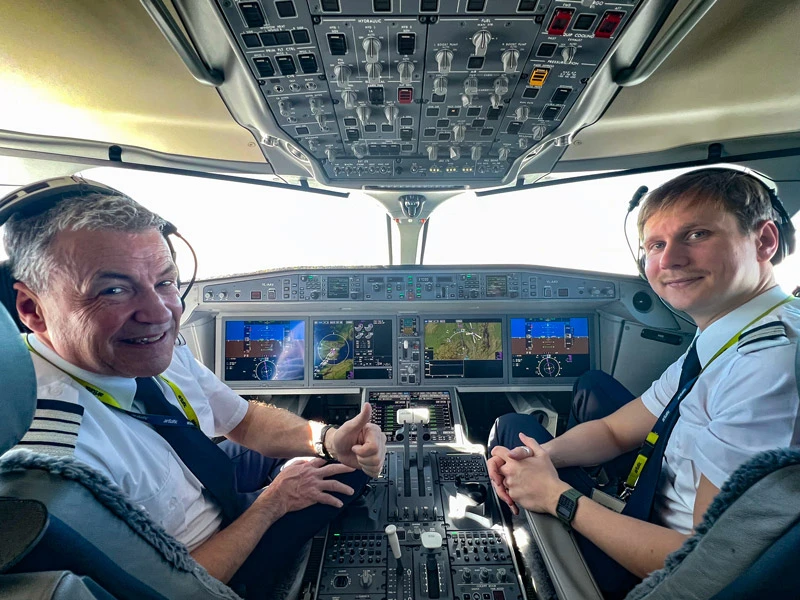
©Andreas Spaeth

©Andreas Spaeth
Now boarding at gate B7 is today’s ride to Tenerife, registered YL-AAV, which was delivered in December 2019. The aircraft features 148 comfortable seats in airBaltic’s configuration, and although the school holidays haven’t started, 143 seats are booked on flight BT761 this morning. Captain aboard this flight to Tenerife is airBaltic chief pilot Gerhard Ramcke. Originally from Hamburg, Germany, he has almost 10,000 flight hours under his belt—3,100 of which on the A220 having spent the past 17 years at airBaltic. There is probably no other captain who has as much experience flying the A220 on very long routes. In December 2016, he took delivery of the world’s first CS300 (as today’s A220-300 was then called) at the factory in Montréal-Mirabel and flew it home over the Atlantic, followed by other delivery flights. Even more impressive in the A220 long-haul story was his epic demo tour in 2019, when he flew an airBaltic aircraft chartered by Airbus all the way from Riga to Australia, New Zealand and several other South Pacific and Asian countries. “That was quite something,” remembers Ramcke with a smile.
This morning’s route is much less exotic for him. The distance to Tenerife today has been calculated to be 2,578 nautical miles (or 4,774 km), including a slight detour to avoid the Russian-controlled Kaliningrad airspace southwest of Riga, which is off-limits because of the Ukraine war. “It’s only a small detour for us, maybe 50 or 80 km on top of what is already the longest A220 passenger flight, but because we now sometimes have to fly lower or make other detours, we have taken 0.3 metric tons more fuel than usual,” the captain explains. Otherwise, the route is very straightforward, connecting the far northeast of Europe with the Canary Islands off the African coast in an almost direct line. “The route has usually very little variation,” reports Ramcke. The total amount of fuel today comes to 14.1 metric tons out of a capacity of 17 metric tons; takeoff weight is 63.7 metric tons, 3.5 metric tons below the maximum takeoff weight. It’s obvious that the A220 has pretty long legs—airBaltic’s CEO Martin Gauss has emphasized that it could even easily reach Addis Ababa or Delhi from Riga.
At 8:49 a.m. local time, the aircraft rotates in Riga, setting straight onto a south-westerly course. It overflies Lithuania, then Poland. From there flight BT76 crosses Germany, barely touching a stretch of the Czech Republic on the way, passes Stuttgart and crosses into Switzerland. Passengers on the left side are treated to an alpine panorama before entering France. Then comes Spain from north to south. “We are now consuming slightly below 1.8 metric tons of fuel an hour, an extremely favorable amount compared to other aircraft types,” enthuses Gerhard Ramcke. “That’s one of the main advantages of the geared turbofan PW1500G engines, the others being its low noise and reduced emissions.” And the pilots are also fond of their workplace: “This is a totally different story than on the Boeing 737, which suffered from an overload of instruments as the cockpit could never be expanded. For us here on the A220, it’s no problem to spend sometimes six hours or more in here,” acknowledges the chief pilot.
After flying out over the Atlantic near the Costa del Sol in Spain and keeping close to the north coast of Africa, it’s finally time to prepare the approach. Directly above Gran Canaria, Captain Ramcke and his Estonian First Officer Kalev Tarma initiate the landing sequence for Tenerife Sur airport, finally turning right sharply and into final approach. At 1:01 p.m. local time, flight BT761 touches down after a flight time of six hours, twelve minutes. Once parked at the gate, Gerhard Ramcke is pleased: “It was a very relaxed flight in the best office in the world—that’s what we have here on the A220.”



